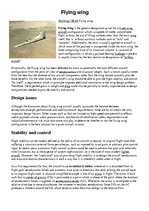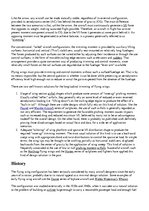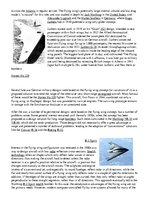Northrop YB-49 flying wing.
Flying wing is the generic designation given for a fixed-wing aircraft configuration which is capable of stable, controllable flight without the aid of lifting surfaces other than the main wing itself, that is, without auxiliary surfaces such as "tails" and "canards". Additionally, the term is usually applied to aircraft in which most of the payload is transported inside the main wing, the latter comprising most of its structural volume. A variation of such configuration in which a payload bearing fuselage is present is usually known by the less restrictive designation of "tailless aircraft".
Historically, the flying wing has been defended by many as potentially the most efficient aircraft configuration from the point of view of aerodynamics and structural weight. Such a notion usually comes from the idea that the absence of any aircraft components other than the wing should naturally provide those benefits. On the other hand, the aircraft's wing should be able to provide flight stability and control "by itself", a requirement which in principle imposes additional constraints to the wing design problem. Therefore, the expected gains in weight and drag could also be partially or totally impaired due to design compromises needed to provide stability and control.
Design issues
Although the discussion about flying wing aircraft usually surrounds the balance between aerodynamic/weight performance and stability/control requirements, those are by no means the only important design factors. Other issues such as (but not limited to) high-speed compressibility effects, useful payload volume, cabin pressurization, satisfaction of certification safety requirements and industrial/commercial risk must also come into play to determine whether or not the flying wing configuration is the best solution for a given aircraft mission.
Stability and control
Flight stability can be loosely defined as the ability of an aircraft to recover its original flight state after suffering a transitory external force perturbation, such as imposed by wind gusts or arbitrary pilot control input.
…




